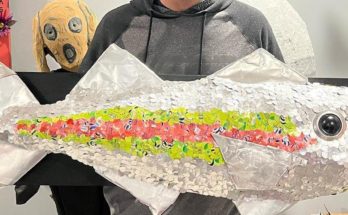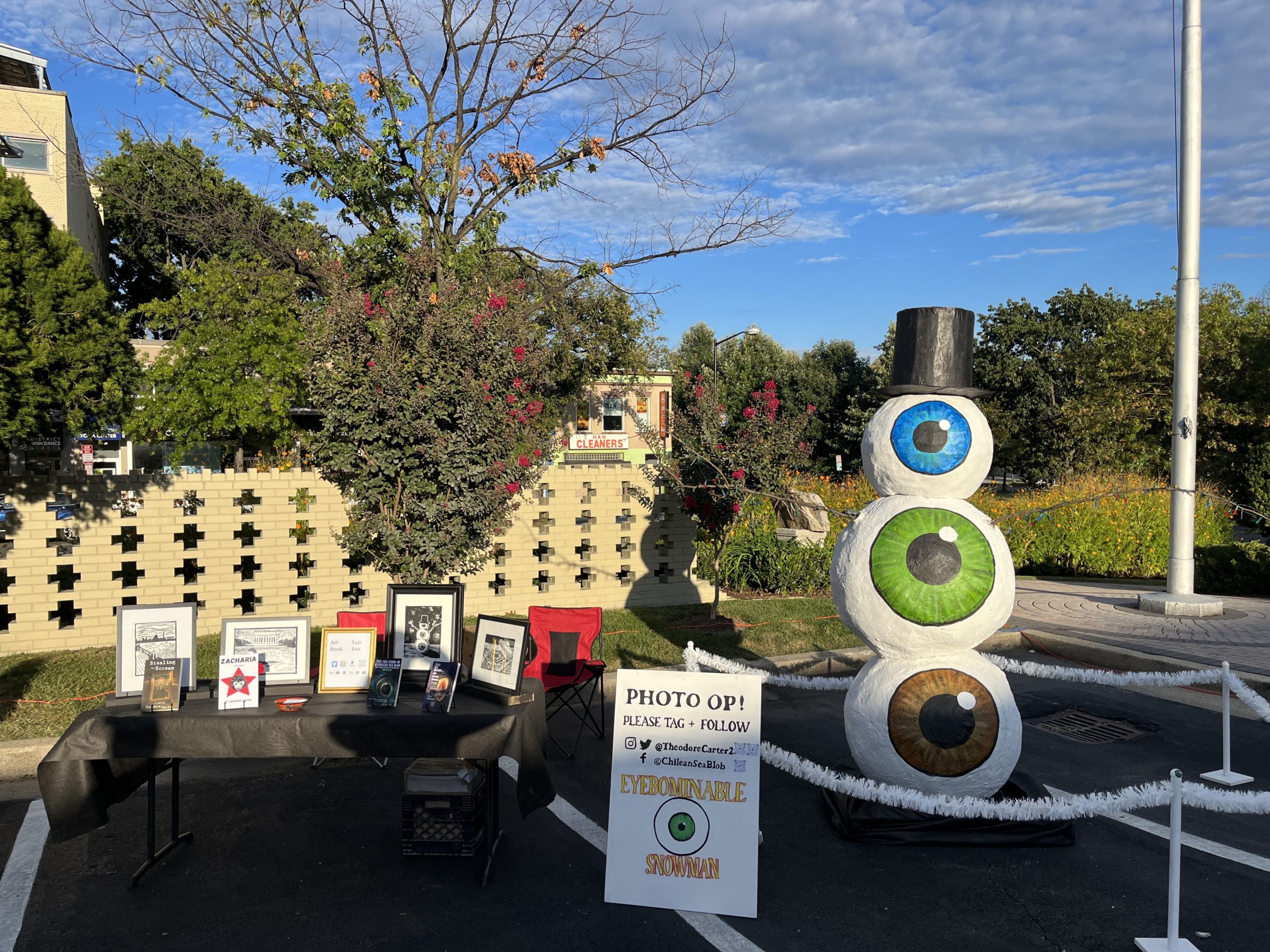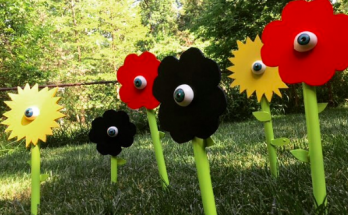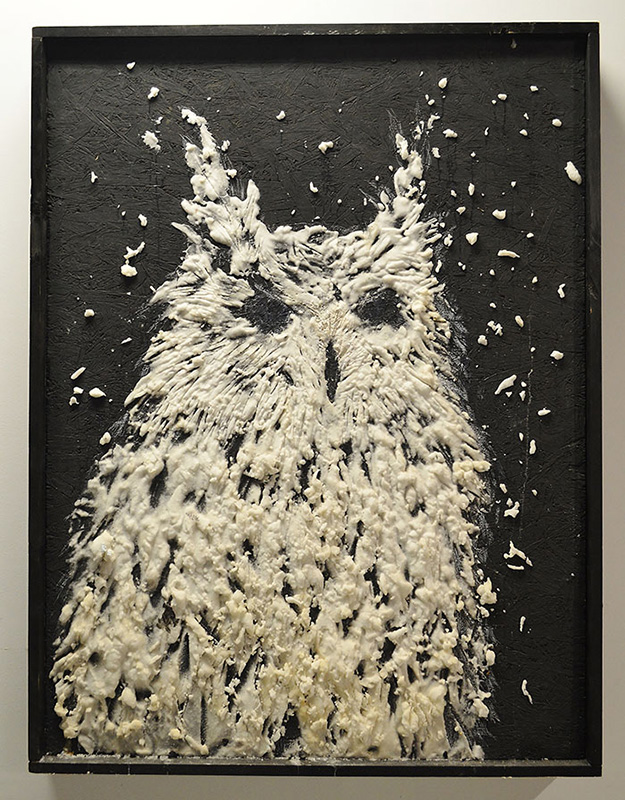
I first encountered Paul Mericle’s work at DC’s Art all Night and was struck by his use of unconventional materials such as an owl sculpted out of sugar. I also picked up a piece of his plywood art from a “take-one-home” bin. Clearly, Mericle has an interest in creating innovative work and sharing that work widely.
I’ve since learned that in addition to gallery shows, Mericle created massive sculptures, painted public murals, and put up wheatpastes around Baltimore. As a teacher at REACH Partnership High School, Mericle is challenging students to look at divisions within Baltimore neighborhoods and to evaluate the utility and value of art.
Below, I ask Mericle about his work.
What is the Recalibration Project? How do constraints drive your work?
Recalibration is a series of works based on crowd sourced constraints. Anyone can suggest materials, color scheme, and subject matter through my webpage. The resulting artworks are relief sculptures made by breaking down and re-arranging materials.
I came up with the idea with the help of my friend Dylan Kinnett, a writer, performance artist, and programmer at the Walter’s Art Museum. I told him that much of my work is constrained by the spaces they occupy, social and physical geography, and the client or curator.
I often have difficulty narrowing a concept if I am not provided with some type of constraint. I think a lot of people are like this. For example, when I’m teaching, I can’t just hand out blank paper to my students and say “write two pages”. If I give them a prompt like “how is the world going to end?” they can dive right in. Too many options lead to indecision.
I like the challenges of constraints, and I have a deep desire to involve others in my artwork. The constraints are like a puzzle to be solved, and the collaborators are pieces working together for a goal. In keeping with that theme, all materials chosen are broken down from their original state, then re-arranged into the subject that collaborator provided: “recalibrated.”
Dylan and I mapped out a form that people can fill out to provide me with constraints. Dylan wrote the program and plugged it into my website.
We got a great response, and I’ve received many amazing ideas. By the time I first exhibited these works, I had attempted about 75% of the suggestions I received. Of those attempts, I was successful about 30% of the time. Some materials are harder to work with than others. I still maintain that Great Stuff spray foam is simultaneously the greatest and worst material on earth.
What are some examples of unique works you’ve created with these constraints?
I think my favorite one was either the cardboard mandrill or the snow owl made from sugar. The cardboard was fun and easy to cut. However, I remember thinking I’d never be able to create with sugar. Then, after some research, I found a really cool (and somewhat simple to make) bonding compound that seals work so it will last decades. I got great feedback from that one and more forms asking for a sugar skulls.
I also enjoyed making a Dorado (fish) out of coal. I got to smash coal with a hammer on that one. I realized during that process how much I like breaking things down.
dorado from Paul Mericle on Vimeo.
I made a piece depicting a Liger (lion-tiger hybrid) out of brick, but that thing weighed almost 80 pounds. No joke. Fortunately, the first exhibition space had cinder block walls.
I made piece of “a young fucked up Robert Downey Jr. playing the piano” out of sheetrock. That one was very time consuming, but fun. I first drew the picture on the sheetrock, then went in and carved away at it with a clay tool. Sheetrock is awesome. You can stain or paint the paper layers glued to the outside and get really smooth or rough textures depending on how much water you use while carving. The result is something that can mess with peoples’ sense of space and depth within the work.
I made another piece of a hippo on a sheet of foamcore. I accidentally got a drop of spray paint on the foamcore while working on another piece. That mistake reminded me that aerosol melts foam. So, I made a stencil and applied stupid amounts of spray onto the work. The process video I made of that was really cool, the time-lapse of the foam melting and bubbling is great.
Foam Hippo from Paul Mericle on Vimeo.
What is the One Piece Project?
I leave out stained and painted cedar shingles for people to take for free at my exhibitions. Originally, they served several purposes. They draw people over to my work, act as business cards, and, most importantly, let EVERYONE have some art to take back from the event. I then started making these things and hiding them around Baltimore, kinda like Easter eggs.
I was working on some cedar planks in class last fall and my students got really into them. We had just finished a small unit on line and shape where they were creating ‘tag’ names. So they started making their own panels. I had a little trouble at the end of the class period because the students wanted to keep their work, but I had planned on hiding them around town. That ‘disagreement’ lead us to several class-long debates and a planning session.
We talked about street art, its roots, and where it is now. The big thing I wanted to nail home with them was that it is meant to be available to everyone. Also, because of the anonymity factor with the artist, serious social issues can be brought to the public. Things people don’t necessarily want to talk about, or may not even be aware of, can be put in the public eye. It can also just be something beautiful that makes you look at things in a different way. For example a wheatpaste on a vacant house, can bring peoples attention to things like abandoned properties, slumlords, homlessness, and so on. We also talked about everyone being part of bigger things like neighborhoods, cities, countries, the world, etc.
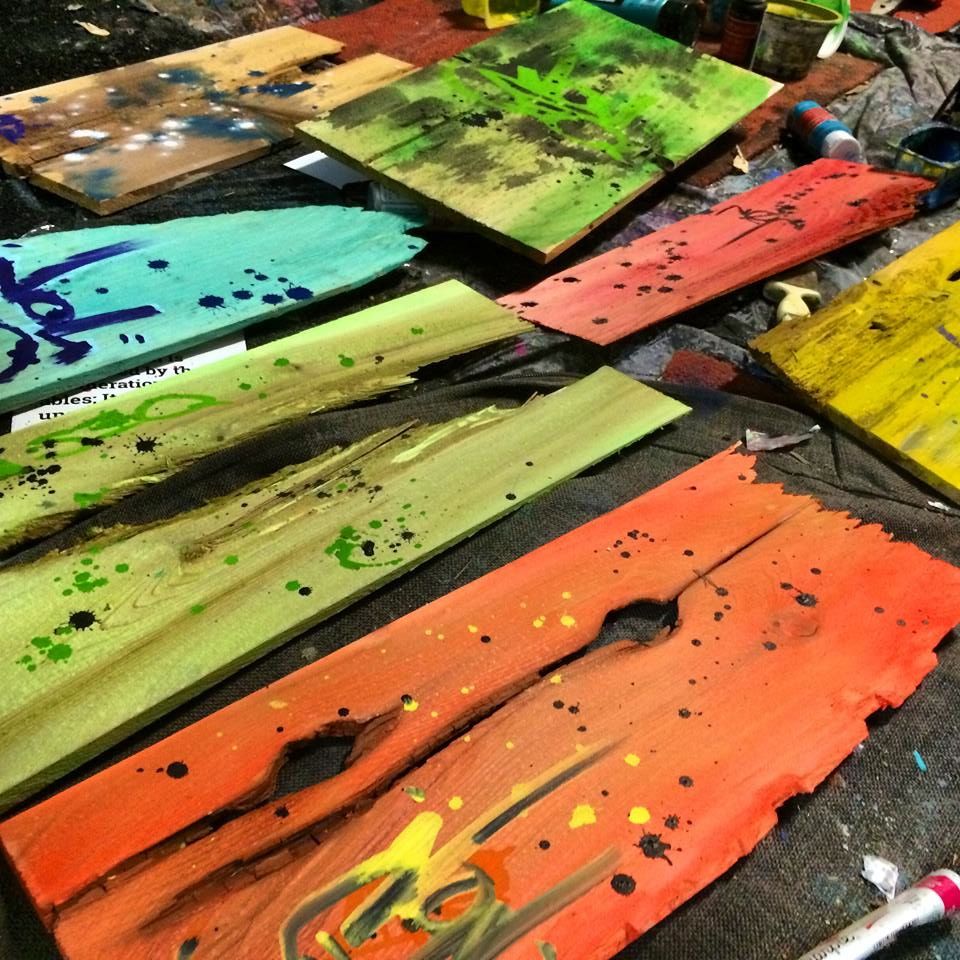
I talked about all of the different neighborhoods where I’d left these things. One of the many crazy things about Baltimore is the divide between the Eastside and the Westside. A corridor of money runs up the middle of the city from Fed Hill to Towson that essentially splits the city in two.
A lot of residents who live outside that corridor see themselves as from the “East” or “West.” I mean, people get very specific and claim, say, the “400 block of Harford Road,” but almost everyone associates themselves with being from either ‘”over East’ or “over West”. This has always intrigued me. Some people will, or have, lived their whole lives without ever visiting the other side. On the flip-side of that, I have students who used to live on the Westside who moved East, they still remain loyal to their original side.
Anyway, this city is so cool, and has so many hidden gems. To expose these gems and bring to light all of the super unique, bizarre, and crazy neighborhoods that are “one piece” of this city, we came up with the idea of the “One Piece Project”.
We want people to find these things (the One Pieces) and have them brighten their day. We also want to show everyone that we are all connected. A student who lives in the Bel-Air Edison neighborhood may now have their artwork in a house in Mondawmin. A student who lives on Greenmount might be recognized as creative and caring person to someone who found their art in Canton.
I have been fortunate enough to land my students some shows at galleries here (in Bmore). At the first show, we made a six-foot-tall triangular tower with paintings on each side. We covered the tower with layers of the “one pieces” and put it on one of the busiest intersections in Baltimore. As people came by and took the “one pieces,” the paintings below became exposed.
We are going place more towers throughout Baltimore and try to create a game to get people to explore this city more. We are also in contact with the housing authority about covering the boarded up windows and doors of vacants in the Oliver neighborhood with brightly colored “one pieces.”
Where can people see your work out in the wild?
There are the one pieces floating around Baltimore and soon, DC. I’ve also got some wheatpastings around the Station North, Remington, Monument Street, and Hollins market areas. I’ve got several murals in Lake Clifton, and one on the corner of North Ave and Howard Street I did with my buddy Francisco Esteban. I have paintings on vacant doors and window panels of a house in Greenmount West. I also have 4 murals on Panels covering a building on the corner of North Ave and Maryland. Those might come down by the time this is published. And finally, I have a sculpture in Leakin Park/Gwynns Falls.
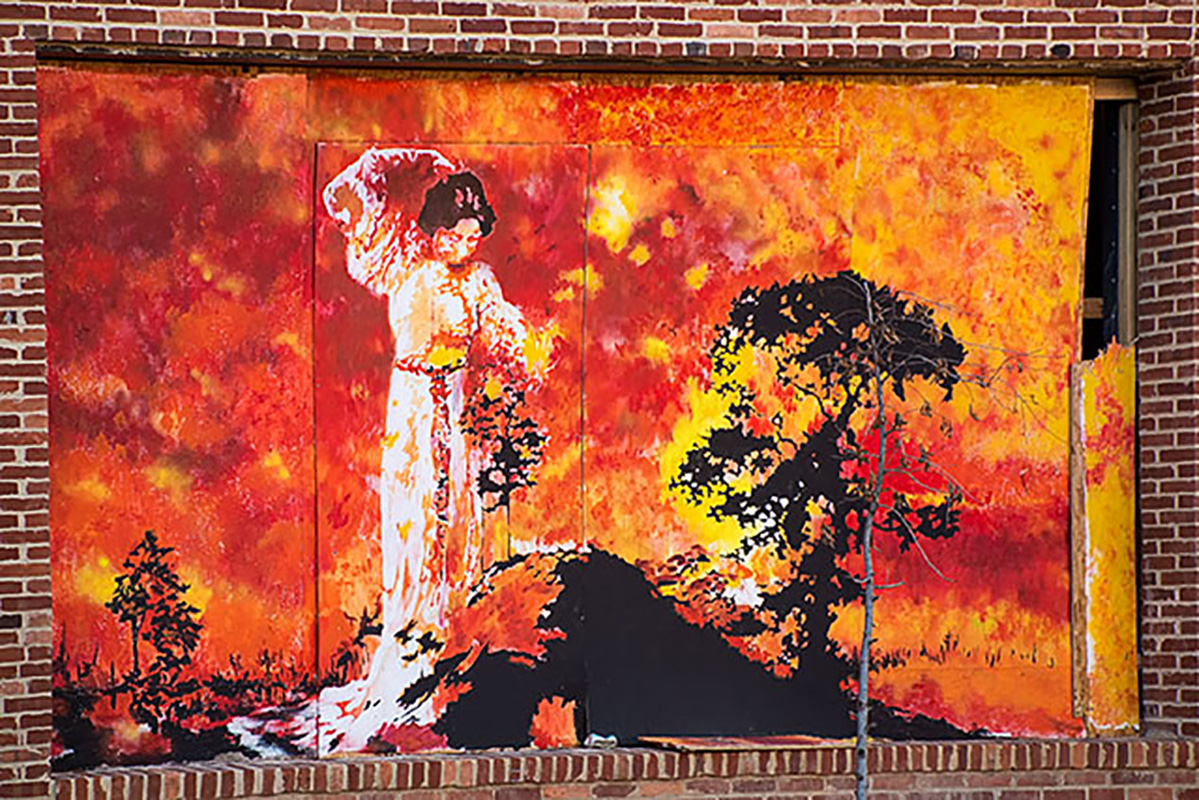
Clearly, you have a focus on engaging the public in your work. Why is this important?
Without an audience what is art? Everyone makes art for someone, or as a response to something even if that someone is themself. I think art is a great vehicle for pointing out beauties and flaws of life. To me, the viewer’s interpretation of my artwork is just as important as my intent. It helps to guide future work, and helps me to understand how other people see the world. The best way to further myself as an artist and person is to consider other people’s interpretation of my art. I want to create a relationship where we both get something out of the deal.
I also just love people and enjoy working with others. I don’t mean leading a group (I actually get extremely nervous), but collaborating and using the amazing things that come about when you combine a variety of experiences and points of view. I also like showing people art isn’t just this thing that only certain people are good at, or that it requires skill with a paint brush to be an artist. I love the feeling I get from interacting with people when they provide ideas that further a project and the pride they get from seeing their ideas come to life.
What are you most proud of as an artist?
That’s a tough one, I guess that’d be a split between a couple of installations I did for pop up galleries with No Kings Collective in DC (Submerge and The Water Street Project). The artists they lined up for those shows were legit, and I had no business showing with them. But for some reason, Peter and Brandon (of NKC) let me make monstrous messes at each show.
I made a 28 ft tall, 34 ft diameter cement tree at Submerge, and created a reflection pond with live fauna and water raining from the ceilingt Water Street. Both of them were in raw warehouse spaces that are now Living Social’s headquarters and Malmasion, a high-end restaurant on the waterfront in Georgetown. I get a kick out of knowing that these giant, ridiculous things were in these now super clean and fancy spots.
What do you still hope to achieve?
I would like to broaden the scope of what the Recalibration project is by involving more people, hopefully creating new work from materials that have not ever been used for what I’m making.
I really would like to see this One Piece Project evolve into something that I can fully hand over to my students, and let them lead the public to issues they see as important.
One Piece Project on Facebook.
Instagram: @pataphysic

